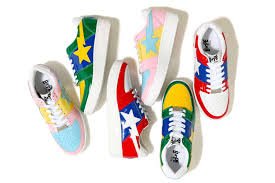The world of streetwear is filled with iconic silhouettes and legendary collaborations, but few sneakers have left as profound an impact as the Bapesta. Known for its bold aesthetic, cultural relevance, and undeniable resemblance to the Nike Air Force 1, the Bapesta has become a cornerstone of Japanese street fashion. Originating from the mind of Nigo, the founder of A Bathing Ape (BAPE), this sneaker is not just footwear—it’s a cultural statement, an art form, and a symbol of authenticity in the ever-evolving world of urban fashion.
The Birth of a Legend
The Bapesta was first introduced in the early 2000s by A Bathing Ape, a brand founded in 1993 by Tomoaki Nagao, popularly known as Nigo. Heavily influenced by American pop culture, hip-hop, and street style, Nigo envisioned BAPE as a brand that pushed boundaries and embraced boldness. At a time when Japanese fashion was leaning toward minimalism, BAPE stood out with its loud prints, shark hoodies, and of course, the Bapesta sneaker.
Nigo took inspiration from the Nike Air Force 1, a silhouette that was already dominating the streets in the U.S. However, instead of merely copying the design, he reinterpreted it with a Japanese twist. The result was the Bapesta, a sneaker that featured a near-identical shape but replaced the iconic Nike Swoosh with a shooting star logo called the “STA.” Its patent leather construction and eye-popping colorways quickly made it a must-have item for fashion-forward individuals around the world.
Design and Appeal
What truly set the Bapesta apart was its daring design. The sneaker came in a range of vibrant colors, from neon greens and yellows to glossy purples and metallic silvers. This wasn’t just a sneaker—it was a canvas for self-expression. The use of patent leather added a glossy finish that made each pair pop even more under street lights and camera flashes. The chunky silhouette, thick sole, and exaggerated logo placement made it immediately recognizable and highly photogenic—qualities that would prove essential in the social media age.
Aside from the aesthetic, the quality of the Bapesta has often been noted. Although some early pairs received criticism for being too stiff or rigid, later models improved in comfort and craftsmanship. But in truth, the appeal of the Bapesta has never been solely about comfort—it’s about making a statement.
Hip-Hop Influence and Global Fame
The Bapesta’s rise to fame was heavily bolstered by its association with hip-hop culture. As American rappers and celebrities began to take notice of Japanese fashion, many became fans of BAPE and Nigo’s creations. One of the most influential figures in the sneaker’s ascent was Pharrell Williams. Along with other icons like Kanye West and Lil Wayne, Pharrell wore Bapestas in music videos, concerts, and public appearances, giving the sneaker a powerful co-sign in the hip-hop world.
In 2005, BAPE’s collaboration with Kanye West on a Bapesta model based on his “College Dropout” album artwork became one of the most coveted releases of the decade. The limited-edition pair sold out instantly and now commands thousands of dollars on resale markets. Collaborations with artists like Soulja Boy, Big Sean, and Kid Cudi further embedded the Bapesta into the DNA of hip-hop fashion.
Cultural Impact and Legacy
The Bapesta’s influence goes far beyond just being a fashionable sneaker. It represents a fusion of East and West, a collision of American streetwear with Japanese innovation. It also introduced the concept of hype culture in a big way to Japan and helped globalize the streetwear scene. Before BAPE and Bapesta, few Japanese brands had achieved mainstream recognition in Western markets. Nigo helped bridge that gap, and the Bapesta became a symbol of cultural crossover.
It’s also worth noting how the Bapesta helped shape the resale market. At a time when sneaker flipping was still a niche activity, Bapesta models were fetching high prices online and in boutique shops. This helped pave the way for today’s sneaker economy, where limited drops and exclusivity are part of a multi-billion-dollar industry.
Evolving With the Times
In recent years, BAPE has continued to reinvent the Bapesta to keep it relevant. New collaborations with brands such as Undefeated, Marvel, and Comme des Garçons have brought fresh perspectives to the classic silhouette. Limited-edition runs, improved materials, and a renewed focus on craftsmanship have helped the sneaker stay relevant in an increasingly competitive market.
Social media platforms like Instagram and TikTok have also played a role in reviving interest in the Bapesta. Young influencers and content creators have embraced the sneaker for its nostalgic value and bold visual appeal. The Bapesta has become a frequent feature in fashion reels, sneaker unboxings, and styling videos, ensuring that a new generation continues to appreciate its unique style.
Controversy and Criticism
Of course, the Bapesta hasn’t been without controversy. Critics have long accused it of being a blatant copy of the Nike Air Force 1. In fact, Nike reportedly confronted BAPE about the similarities, which resulted in a period of decreased production for the Bapesta during the mid-2010s. However, recent years have seen the sneaker return in full force, with enough of a cultural identity to stand on its own merits.
While opinions remain divided, most fashion enthusiasts agree that the Bapesta is more than just a copy—it is a reimagining, a reinterpretation that captures the ethos of a different culture while paying homage to a classic. Its influence, collaborations, and design innovation have cemented its place in fashion history.
Conclusion
The Bapesta is more than just a sneaker—it’s a cultural artifact. Born out of creativity, inspired by hip-hop, and driven by Japanese innovation, the Bapesta has carved out a niche that few sneakers can claim. Its loud design, iconic branding, and connection to influential artists make it one of the most recognizable and respected sneakers in streetwear culture.







